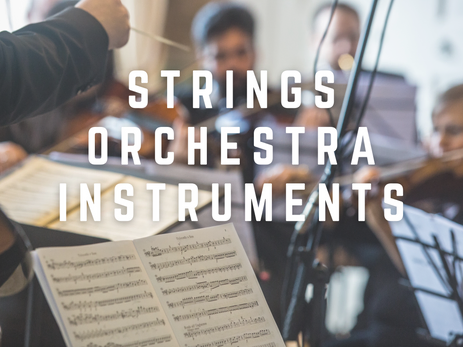Uncategorized
Strings Section Orchestra Instruments
UNDERSTANDING Strings Section Orchestra Instruments
https://www.youtube.com/watch?v=AjQRR_60BeY&t=6s
Have you ever wondered how many string players are in an orchestra?
Would you like to know the range and the tuning of the string instruments that make up this section?
We encourage you to go through this article and keep learning about Orchestration!
The Symphony Orchestra is divided into four sections:
Strings Section Orchestra Instruments are: Strings, woodwinds, brass, and percussion.
The string section was the first to be fully developed and exploited by composers. The reasons composers gave preferential treatment to the string section are as follows:
- Its enormous range, encompassing seven octaves between the double basses and the violins
- Timbral homogeneity throughout its entire range
- Its wide dynamic range, from a barely audible pianissimo to a thunderous fortissimo
- The richness of tone quality, allowing it to play wonderfully expressive passages
- Its versatility in producing different kinds of sound as well as executing from fast passages to long slow notes
The string section of a symphony orchestra consists of the following number of players, with two players sharing each stand:
First violins 16 to 18 players 8 or 9 stands
Second violins 14 to 16 players 7 or 8 stands
Violas 10 to 12 players 5 or 6 stands
Cellos 10 to 12 players 5 or 6 stands
Double basses 8 to 10 players 4 or 5 stands
TUNING
Three of the string choir instruments, the violin, the viola, and the cello, are tuned in 5ths. The remaining member of the family, the double bass, is tuned in 4ths.
Tuning of the Violin Strings
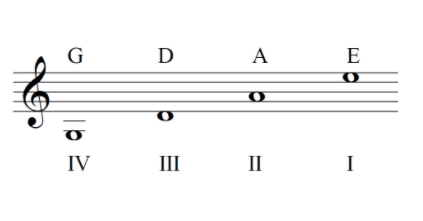
Tuning of the Viola Strings
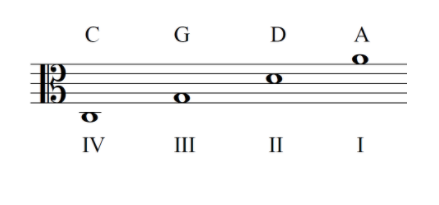
Tuning of the Cello Strings
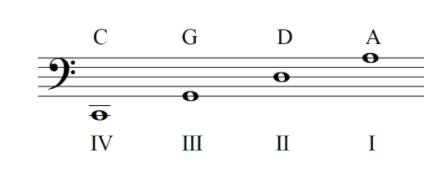
Tuning of the Double Bass Strings
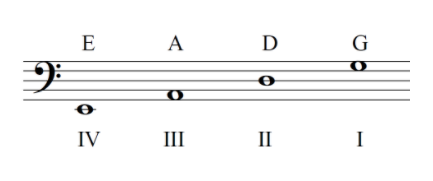
VIOLIN
The violin is the soprano instrument in the string section. For this reason, violin music is written in the treble clef.
The range of the violin extends from G3 to E7
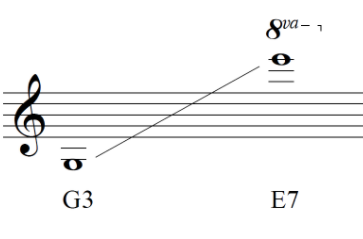
VIOLA
The viola is the alto voice in the string orchestra. Viola music should be notated in the alto clef, but to avoid ledger lines, the upper notes are sometimes written in treble clef.
The range of the viola extends from C3 to A6
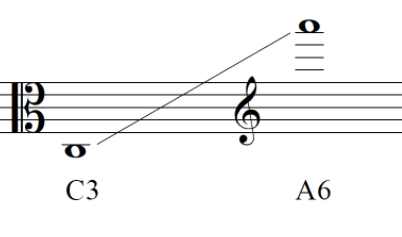
CELLO
The cello is both the tenor and the bass of the string section. With this in mind, in addition to its wide range, we understand why music for cello is written in the bass, alto, and treble clef.
The range of the cello extends from C2 to G5
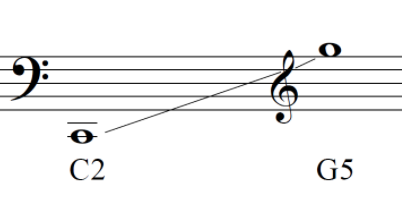
DOUBLE BASS
The double bass is the real bass voice of the string choir. All music for the double bass is written in bass, tenor, or treble clef.
The range of the double bass extends from E2 to Bb4
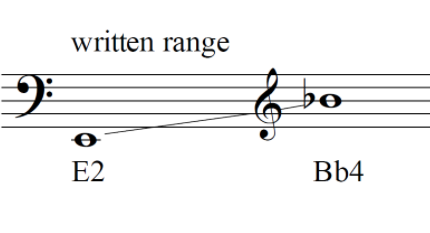
We hope this information has been useful to you.
In order to close this article, we will quote a phrase from the famous composer Rimsky-Korsakov
“Orchestration is part of the very soul of the work. A work is thought out in terms of the orchestra, certain tone-colors being inseparable from it in the mind of its creator and native to it from the hour of its birth”.
UNDERSTANDING BOWING
https://www.youtube.com/watch?v=b63wBKVe2rg&t=7s
For the past 400 years, composers have given preferential treatment to the Strings Section Orchestra Instruments.
One of the reasons this happened was because of the versatility of string instruments in producing different kinds of articulations.
This section will focus on the most common types of bowings and articulations used in western orchestral literature.
When string players draw the bow across the strings, they do so in two possible directions:
- From the frog toward the tip (down-bow)
- From the tip toward the frog (up-bow)
NON-LEGATO
When string players perform a non-legato passage, they change the direction of the bow each time they play a note.
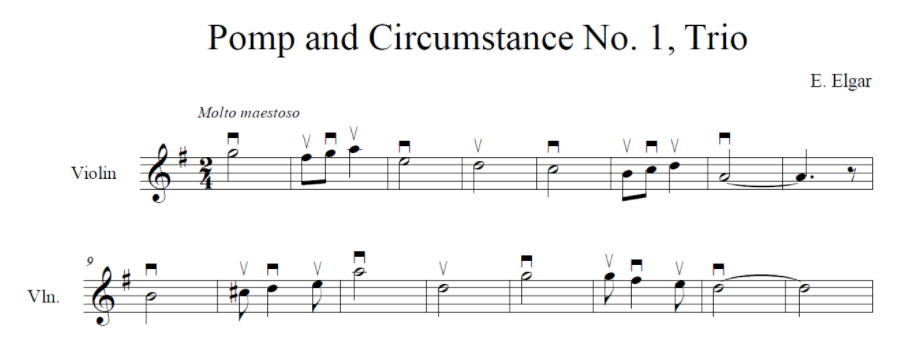
LEGATO
Legato means “bound together”. In order to play legato, the player must play all the slurred notes in one bow direction.

Besides legato and non-legato there are other types of bowing. We can classify the different types of bowings according to two categories:
- Bowings in which the bow stroke remains on the string. There are four types of bowing that belong to this category: détaché, portato, staccato, martellato.
- Bowings in which the bow stroke is made to bounce off the string. There are 3 types of bowing that belong to this category: spiccato, jeté, arpeggiando.
DETACHE
Détaché is a french word that means “detached”. In order to execute this bowing, the player must change the direction of the bow for each note.

PORTATO
There are two different terms for this type of bowing. Portato is the Italian term and louré the french one.

STACCATO
Staccato is an Italian word that means “separated” or “detached”. This articulation is indicated by placing a dot above or below the notehead.

MARTELLATO
Martello is an Italian name that means “hammer”. Martellato means “hammered”. When it comes to music, it means a well-articulated, heavy and separate stroke.
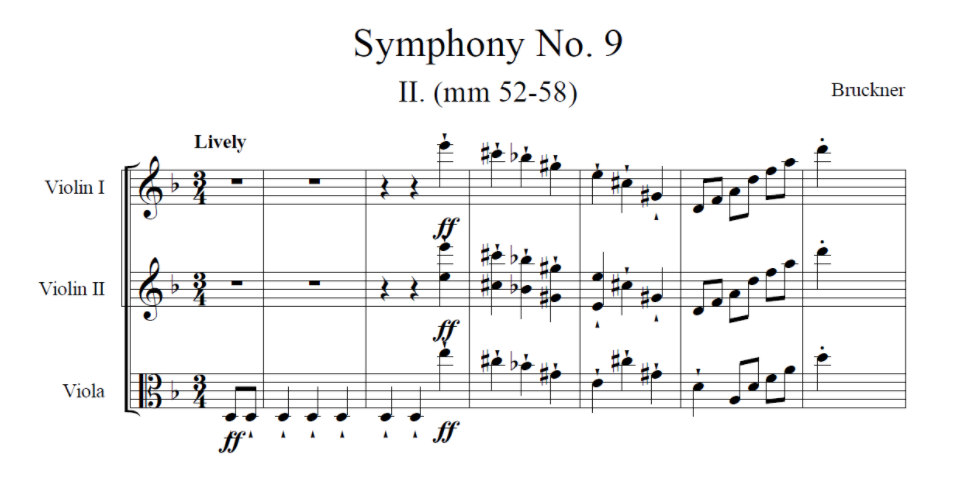
SPICCATO
There are three different types of spiccato bowing: conscious spiccato, spontaneous spiccato, slurred spiccato. Next, we will see the main features of each one.
CONSCIOUS SPICCATO
This type of spiccato is effective when used in slow or moderate tempo. In order to execute this articulation, the player has to make a conscious effort to make the bow bounce.

SPONTANEOUS SPICCATO
This type of articulation happens when, in a fast tempo, the bow spontaneously bounces off the strings.
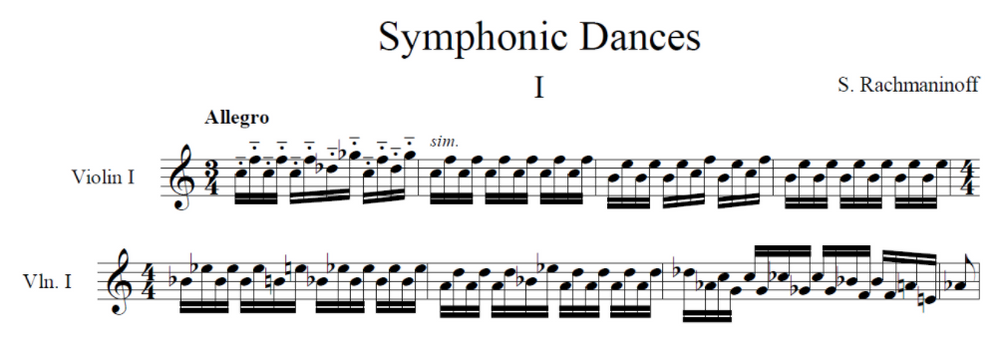
SLURRED SPICCATO
This articulation consists of several slurred spiccato notes played in a single bow.
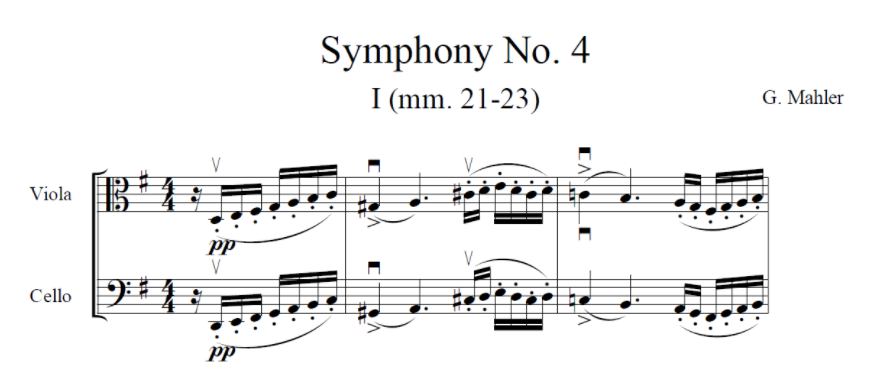
JETE
There are two different terms for this type of bowing. Jeté is the french term and ricochet is the English one. This articulation consists of producing several fast pitches by throwing the upper part of the bow on the strings.

ARPEGGIANDO
Arpeggiando occurs naturally when playing arpeggios on different strings at a fast tempo. The example below shows an arpeggiando on the violin solo part taken from Mendelssohn’s violin concerto.
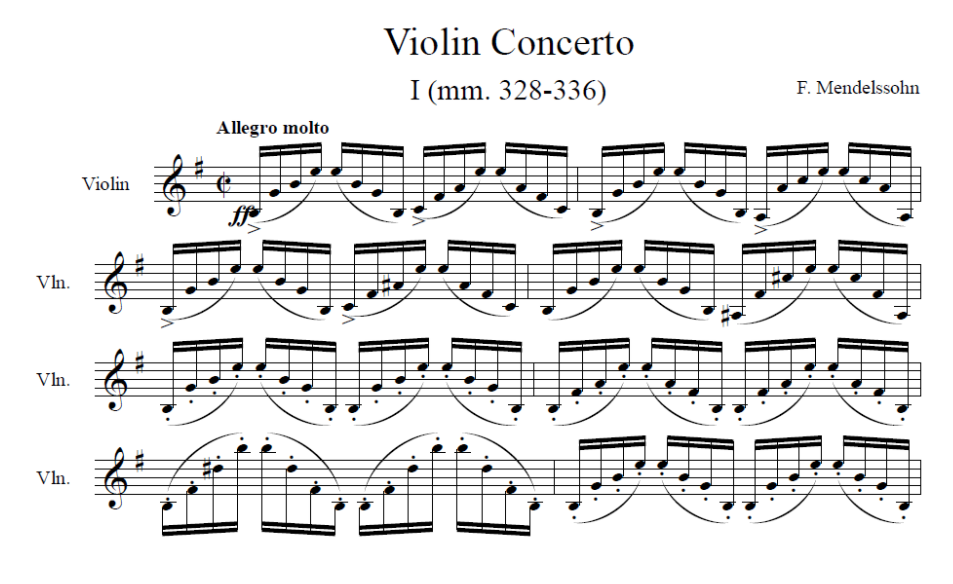
ORCHESTRATING SCHUMANN’S KLEINE ROMANZE
Strings Section Orchestra Instruments Schumann’s Romanze:
https://www.youtube.com/watch?v=uKYJbpsM5O0
This section will orchestrate Schumann‘s Kleine Romanze Op. 68, No. 19 for String orchestra.
First of all, we will analyze the piece and then we will see how to orchestrate it.
When we are looking forward to orchestrating a piece, we have to analyze the piece until we have a deep understanding of the compositional devices, harmonic progressions, and formal structures employed by the composer.
Next, we are going to illustrate step by step how the analysis and orchestration should be done.
ANALYSIS
Let’s start by doing an analysis of the first eight bars:
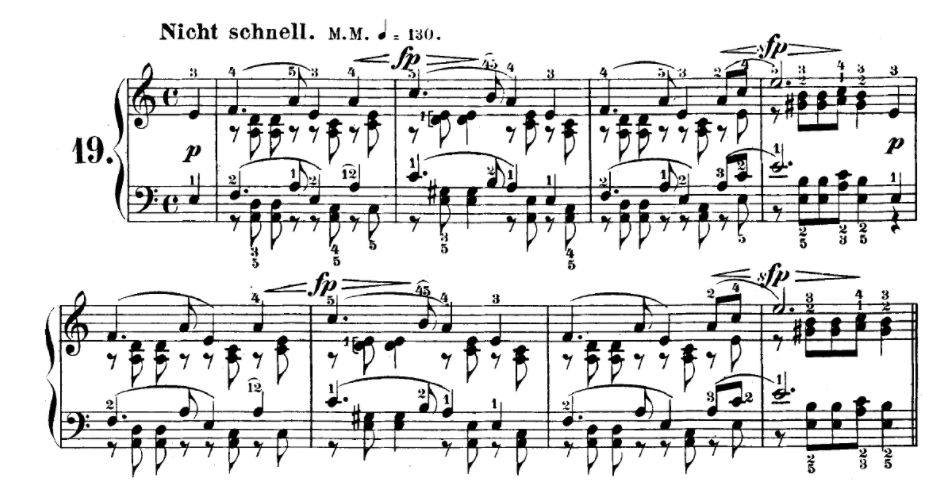
What’s the key?
The key of this section is A minor. It is important to notice that instead of starting with the tonic chord, the piece begins with subdominant in the second inversion.
What’s the texture?
The texture of this excerpt is a melody with accompaniment. The melody is written in the top part of the right hand and it is doubled, an octave lower, by the left hand.
What’s the form?
The first section of the piece is made up of 8 measures which are divided into 4 + 4. the first 4 bars make up a phrase that rests in a half cadence while the second group of 4 measures are an exact repetition of the first one.
Harmony?
In order to facilitate the analysis, we have made a reduction that illustrates the chords and the melody.

How to orchestrate this excerpt?
The ambitus of the right-hand melody extends from E4 to E5. The most sensible option is to assign this melody to Violin I since the ambitus of the melody coincides with the register of the violin.
Following the same logic, we can infer that the melody of the left hand can be played by the viola.
We have already decided which instruments will play the melody. The next step is to see how to orchestrate the accompaniment. A convincing solution would be to assign the left-hand accompaniment to the cellos in divisi.
In the same way, we will assign the right-hand accompaniment to Violin II in divisi.
The result will be the following:
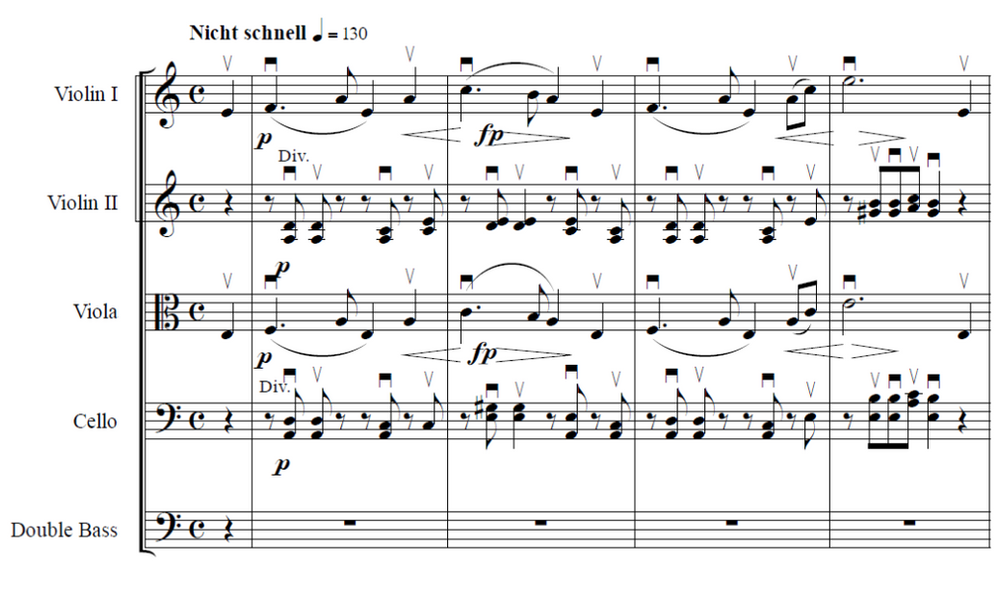
Let’s focus on the next section:
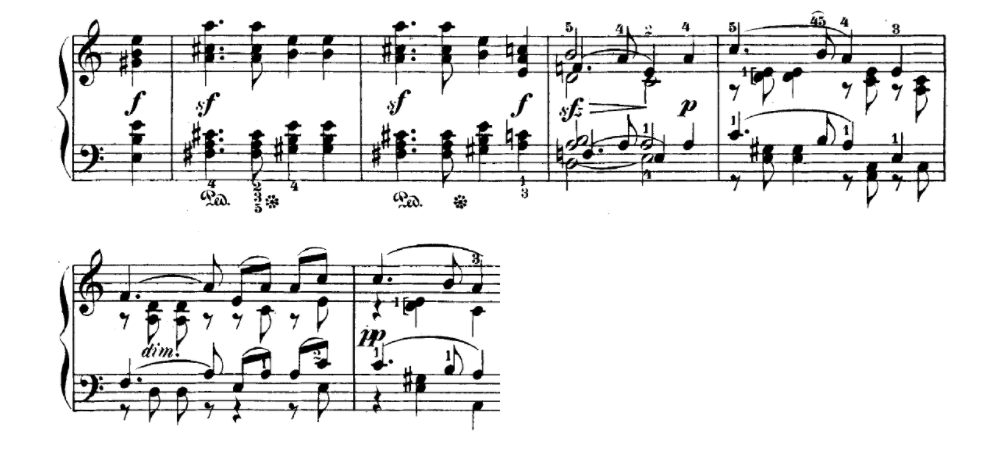
The first two bars of this section feature contrasting material. This contrast is evidenced in:
- The change of key: these two measures are in A major instead of A minor.
- The texture: the six voices that make up this texture have the same rhythmic figuration. Therefore we say that the texture is homorhythmic.
- The dynamic: in the first section, the prevailing dynamic was piano. In these bars, however, the dynamic is forte.
- The sustaining pedal mark: This is the only place in the entire piece where we see a sustaining pedal indication. This is a great opportunity to use the double basses. They can simulate the effect of the sustaining pedal while creating contrast.
In the following example, we illustrate an effective way to orchestrate this passage using violins II and cellos in divisi.
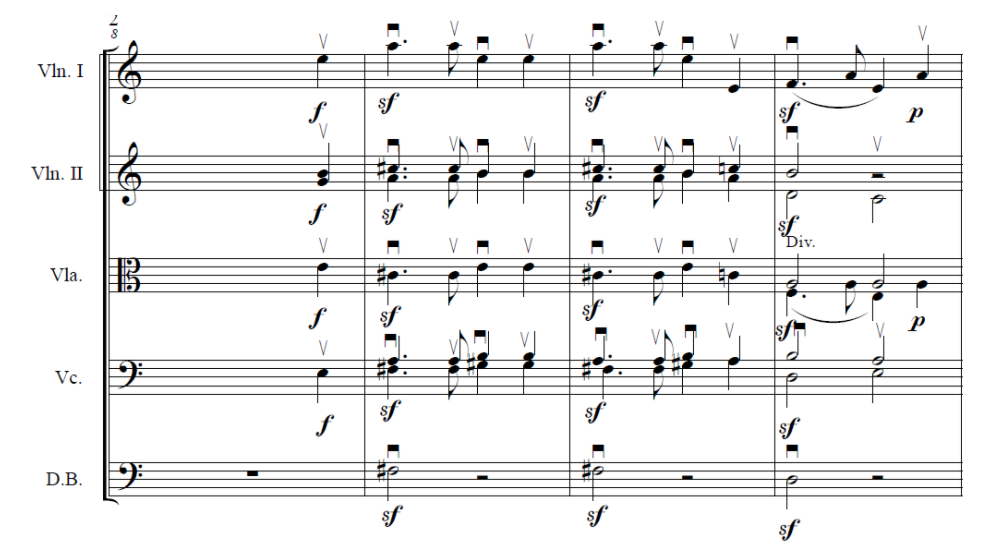
If you look closely at the last example, you will see that the melody from the first section appears again. That’s the most difficult passage to orchestrate in the whole piece. Let’s see how to do it!
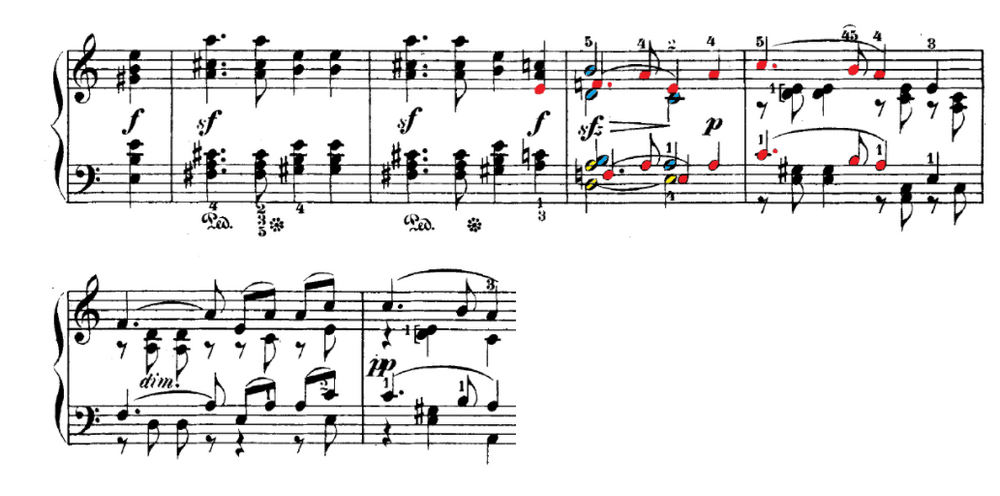
The part marked with red is the melody. We will orchestrate the melody the same way we did at the beginning: Violin I and Viola.
The parts marked with blue must be played by Violin II in divisi. Notice that, apart from divisi, half of the players will have to play a double stop with the notes D-B.
The parts marked with yellow must be played by the Cello.
The result will be the following:
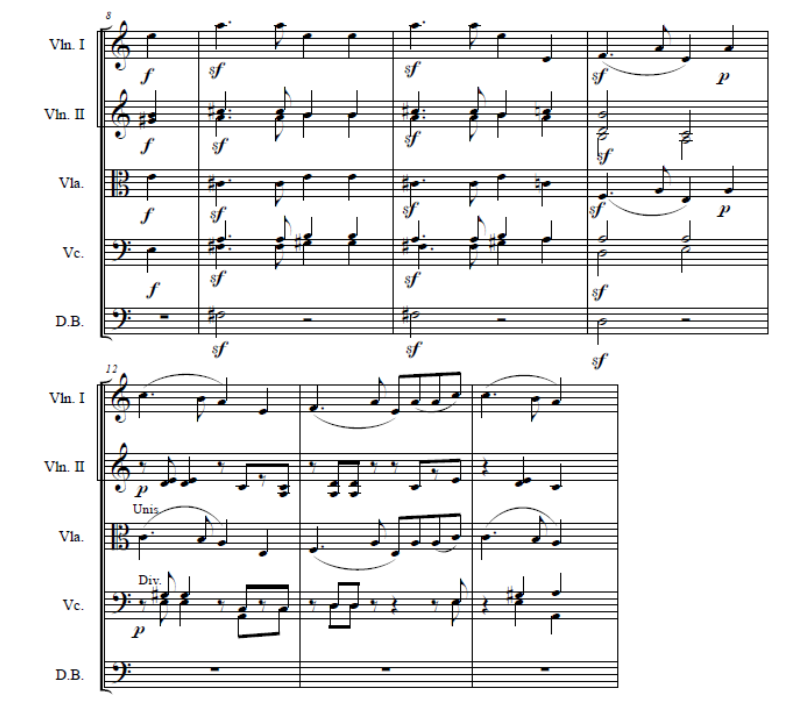
Hoping you enjoyed our Strings Section Orchestra Instruments post, and now you can continue learning Orchestration with our related posts:
– Transcribing from piano to strings

